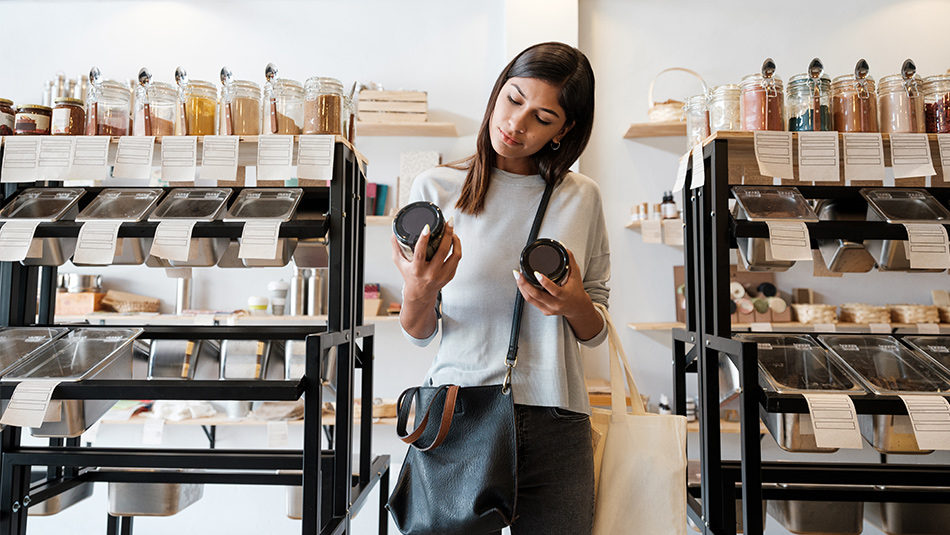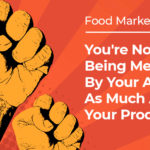
3 Consumer Value Shifts That Will Have an Impact on Food Marketers in 2021
If you’re reading this, it means you survived the most disruptive year in modern history. Profoundly put by Brené Brown, 2020 was the year of the FFT or “effin’ first time.” If there’s anything we learned in 2020 (where do we even begin?), it’s that there were a whole lot of FFTs for consumers. In the wake of an unprecedented global health crisis and political and racial tensions not seen by several generations, consumers quickly adapted to the changing environment, and in doing so, over the course of the past year, developed a new set of behaviors and values. Pinterest described this phenomenon best: “When everything breaks, so do the norms. This year won’t be about ‘back to normal’ or even ‘the new normal.’ Nobody cares about ‘normal’ anymore.”
As food marketers, listening to and responding to these shifts in consumer values will be critical to our success over the next year. Here’s a snapshot of just three of the key consumer values that will drive changes in the way consumers interact with your brand in 2021. Understanding these sentiments will help you prepare for what’s ahead.
1. Transparency and the Quest for Ethically and Sustainably Sourced Foods
Quite simply put: “Coronavirus has put a premium on truth.” In the food world, coronavirus turned a spotlight on vulnerabilities in the supply chain. With unprecedented shortages and delays, consumers began to consider the origins and environmental impact of the food they buy and consume. With 6 in 10 consumers interested in learning more about where food comes from, transparency in the food supply chain will dominate consumer interest and buying behaviors in 2021 and beyond. And as marketers, we need to meet these evolving ethical and environmental demands.
Growing Interest in How and Where Food Is Grown
In 2020, stories like “You’re Buying Garlic That Is Bleached, Grown in Sewer Water and From China” surfaced online. Just 10 years ago, 100% of the garlic bought and consumed in the United States was domestically grown. Today, that number is only 60%. Online searches for where to buy domestic garlic saw sharp increases, and conversations were abuzz on social media in food-centric cultural and health-related Facebook groups like Italian Original Recipes Customs and Cultures and Keto for Beginners, among others. Point is – this year, consumers became more aware of the impact importing has on local farmers and suppliers, and their eyes opened to inferior health regulations set in other countries. In effect, consumers are growing thirsty for knowledge and transparency about the origins of the food they consume to help them make informed and responsible buying decisions. The growing trend toward healthier, ethically and sustainably sourced foods is broadening and heightening consumer expectations.
Reducing Carbon Footprint Is Top of Mind
The year 2020 saw a 30% increase in searches related to sustainable eating, including key phrases like “beef carbon footprint” and “climate change food calculator.” To reduce carbon footprint, consumers say they will be cutting back on meat consumption and will be trying their hand at eating a more plant-forward diet. Expect them to start looking for more clean-label foods, buying from local sources and supporting brands that take their concerns to heart.
Key Takeaway
In 2021, marketers have to be transparent – open and honest about supply chains and ingredients – and practice corporate social responsibility to show they care in authentic and genuine ways. Show consumers that your brand recognizes the role it plays – not just in their kitchens, but in local communities and in the greater environment. Now is the time to integrate positive stories about the product life cycle, local and environmental impact, and sustainability into your marketing communications.
“Transparency and trust have moved beyond marketing concepts to become a genuine and necessary focus.” – WGSN
2. Well-Being: Consumers Take a Realistic Yet Fully Integrated Approach to Health
Not surprisingly, consumers have been focused on prioritizing their health and immunity over the past year. And in 2021 there are no signs of slowing down. With many consumers less willing or unable to afford visits to the doctor, consumers are taking health and wellness into their own hands, turning to functional foods and supplements to support health and well-being.
Integrated Approach to Well-Being
With everything consumers went through in 2020, whether from job losses, financial concerns, new work-from-home schedules, homeschooling children online, to feelings of loss or isolation and uncertainty about the future, in 2021 consumers are finding their mental health inextricably linked to their physical health. And so what we are going to see in 2021 is more of a mindful and integrated approach to health and well-being.
With gyms still compromised, home fitness will continue to grow. According to Pinterest, sleep care will be the new self-care, and bedtime routines will become more important than ever before. From utilizing home goods like diffusers for better sleep, to nighttime herbs and supplements, to bedtime yoga and meditation routines, in 2021 consumers will bring more intention to their sleep-time regimens. Consumers will be taking it a step further too, embracing a full spectrum of well-being, tapping into their mindful, spiritual and even mystical sides. Case in point: Pinterest searches for protection crystals +100%, manifestation techniques +105% and zodiac sign facts +600%.
Flexitarianism: The New Non-Diet Diet
In terms of weight management, the collective experience over the course of 2020 was a true enantiodromia. By July, more than three-quarters of Americans had gained up to 16 pounds. In the fall months, 63% of Americans were prioritizing weight loss to counteract the dietary choices they made earlier in the year (banana bread and sourdough starter, anyone?), seeking out specific diets and meal-prepping strategies to help. By the time the holidays came around, many consumers were fatigued and deprioritized these weight-management behaviors. At the onset of 2021, we’re finding consumers are taking a more realistic approach to weight management. They’re not striving for perfection, but rather, they just want to make better choices. According to Healthline, we saw a 156% year-over-year increase in search interest around flexitarian meal plans towards the end of 2020. Simply put, consumers are looking for sustainable weight-management solutions and aren’t looking for fad diets or quick fixes. In 2021, consumers will be less willing to commit to extreme diets. Instead, we’ll see them prioritize health and gravitate towards ways of eating that allow more flexibility.
Key Takeaway
In 2021, the role of the food marketer will be to highlight the health benefits the product can provide. Second, we will be challenged with positioning the brand as a champion for an integrated and sustainable approach (not a quick fix) to well-being and weight management by driving home the realistic, simple ways the product enhances their lives. With so many facets of well-being to consider, join the conversation in a credible and meaningful way that is authentic to your product. Third, help consumers feel prepared to face challenges with nutrition and time, with easy hacks and meal-prepping pointers. Taste x Simplicity x Health Benefits = Holy Grail. Last, think about how you can cater to some of your more open-minded health-conscious consumers by thinking outside of the kitchen and into broader lifestyle definitions of well-being.
3. Connection With Intention, and Nostalgia’s Sweet Comeback
According to eMarketer, 56.7% of US advertising and marketing professionals believe all future events will have a virtual component. The paradox we find ourselves in now is we’re all craving human connection but simultaneously burned out – suffering from countless virtual meetings, one of 2020’s coined phrases, “Zoom fatigue,” the feeling of being always on but seldom connected in our increasingly asynchronous society. This will make it more of a challenge to meaningfully connect with our audiences.
Connection With Intention
To paraphrase Priya Parker, the author of “The Art of Gathering: How We Meet and Why It Matters,” so many of our gatherings – whether in person or virtual, business related or otherwise personal – are on autopilot and don’t really take into account the “why” for meeting. Hence, we miss an opportunity to engage with people in meaningful ways. Simple, yet profound.
In 2021, food marketers, in order to meaningfully connect with B2C and B2B audiences in virtual formats, will need to become better at designing virtual experiences based on insight and need – “gatherings flourish when real thought goes into them.” Not only will we need to be more strategic and purposeful when creating event experiences, but we’ll also be challenged with using engagement tools more effectively and efficiently, to create psychological cues for guests that emulate the real world. For example, think of creating a space to enter your virtual event, to “hang your coat when you come in,” for example.
Creating additional cues around audience behaviors in the real and virtual worlds will clear the path for collecting more meaningful data to inform high-quality post-event engagement and conversions.
Nostalgia’s Sweet Comeback
When it comes to connection, consumers want more than just food; they want the feeling that comes with it. The desire and appreciation for emotional connection has never been higher than it is today. And this will inform consumers’ behavior and purchasing decisions in 2021 and beyond. Consumers will reach for food and beverage products that spark positive memories and nostalgia, celebrate their upbringing or background, and have the ability to make them feel connected to their loved ones. McCormick is a great example of a brand that nailed this sentiment during the holiday season.
Key Takeaway
First, be intentional and purposeful when it comes to your virtual gatherings. The strategic lens through which we approach virtual events gives food marketers the opportunity to design meaningful experiences. Focus on high-quality engagement, not just during the event, but also pre- and post-event. Clearly identifying these moments will pave the way to identify opportunities and measure key KPIs in real time (one of the advantages of virtual) and move the consumer closer to conversion. Second, consumer connections with food are both personal and shared. Celebrate this by focusing on messaging that not only makes the consumer feel seen and understood but also drives home the power of shared mealtime moments, whether they are together or apart. If your product has any traditional or nostalgic components, now is the time to lean into that.
Although Consumers Are Realistic, the Future Is Bright
While it remains to be seen what FFTs 2021 has in store, setting your sights on fostering Transparency, Well-Being and bringing more Intention to the way we connect will be valuable for food marketers in the year ahead. Although 2020 was a truly challenging year, consumers are feeling cautiously optimistic about the future, and most believe the future is bright. Even though most consumers will be spending the front end of the year at home, they’re dreaming and making big plans for the latter half of 2021. This year, you can appeal to both their realistic and aspirational sides as we collectively redefine what’s “normal.”





